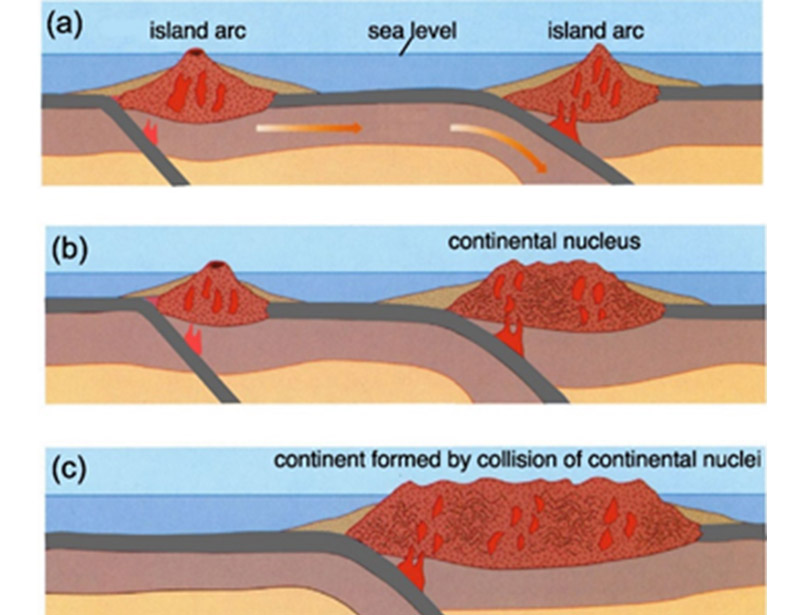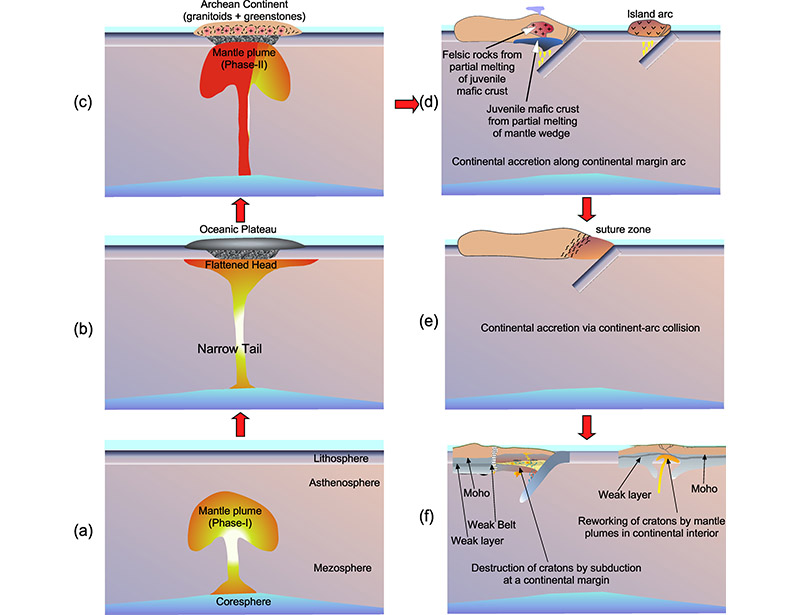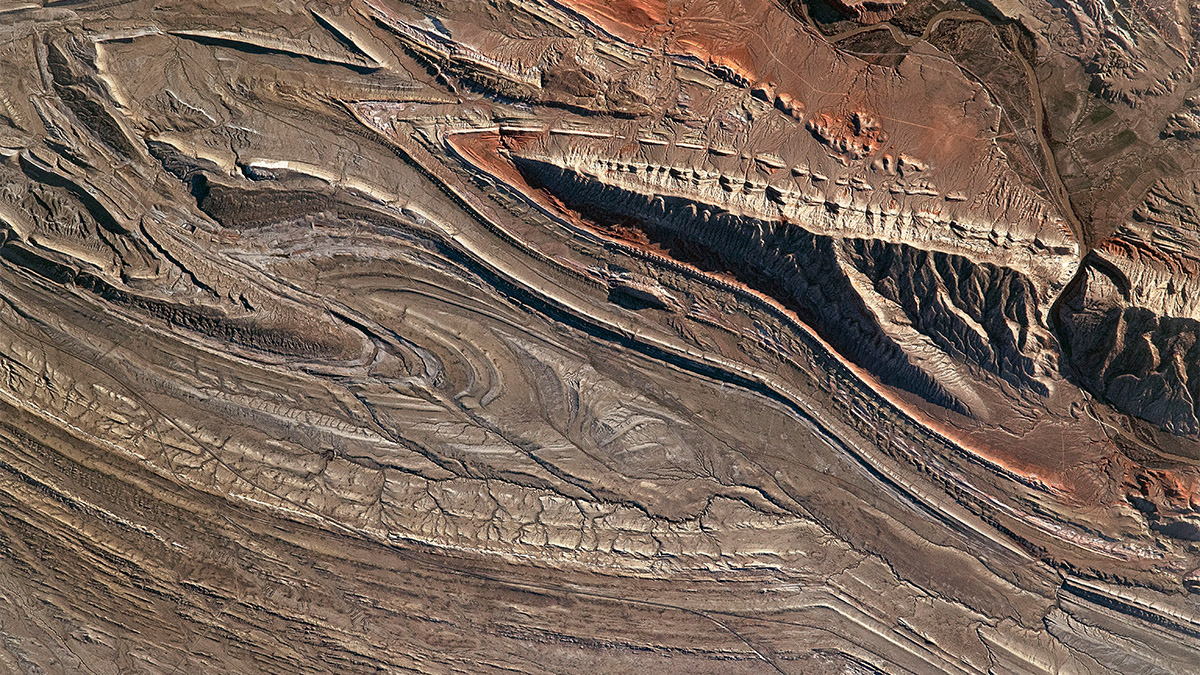Editors’ Vox is a blog from AGU’s Publications Department.
All solid planets in the solar system have a core-mantle-crust structure, but the Earth is a unique planet with a continental crust on which human life exists. Controversies have long surrounded the origin, growth, and reworking of continents. These are explored in a recent article published in Reviews of Geophysics , which also proposes a new synthetic model. Here, the authors describe the characteristics of Earth’s continental crust and the models that describe its origin and dynamics then outline some of the unsolved questions that need additional research.
What are the main differences between continental and oceanic crust?
Continental crust and oceanic crust constitute the outer layer of the Earth but they have distinct differences. First, continental crust is dominated by felsic rocks (feldspar- and silica-rich) in its upper part and mafic rocks (magnesium and iron-rich) in its lower part, while oceanic crust is dominated by mafic rocks. Second, continental crust is older (as old as 4.0 billion years) and buoyant (about 2.7 g/cm3), and usually cannot easily subduct, whilst oceanic crust is younger (<200 million years), denser (about 2.9 g/cm3), can subduct, and is constantly destroyed and replaced at plate boundaries. Third, continental crust is typically 30 to 50 kilometers thick, whilst oceanic crust is only 5 to 10 kilometers thick. Finally, felsic continental crust is unique to the Earth in the solar system, and its origin cannot be well explained by the theory of plate tectonics.
How does plate tectonic theory explain continental crust formation?
Established in the 1960s and regarded as a revolution in Earth sciences, the plate tectonics theory has been applied to interpret continental crust formation. According to the plate tectonics theory, the mafic lower crust and the felsic upper crust of continents can develop from an “island arc” that forms by subduction of one oceanic crust beneath another. The mafic lower crust of continents can be extracted from the mantle through partial melting of the mantle wedge in the subduction zone, whereas the felsic upper crust of continents can form by partial melting of the already-formed mafic lower crust.
However, this island arc model is problematic in terms of explaining the origin of continents in the Archean, the period of 2.5 to 4 billion years in the history of Earth evolution. Specifically the model cannot explain the origin of bimodal volcanic and plutonic assemblages, presence of ~1600ºC MgO-extremely rich rocks (called komatiites) and dominant dome-and-keel structures, and lack of ultra-high-pressure rocks, paired metamorphic belts, and typical ophiolites in Archean continents.

What is a “mantle plume” and how does it explain the origin of Archean continents?
A mantle plume is a cylindrical thermal upwelling of large, voluminous, low-density material that originates mostly from the core-mantle boundary at a depth of about 2,900 kilometers. It is generally composed of a huge head with mafic (basaltic) composition and a narrow tail with ultramafic (komatiitic) composition. When the head of a mantle plume reaches the surface, it produces continental flood basalts on continents and oceanic plateaus with diameters ranging from 1000 to 2000 kilometers on ocean floors.
More and more researchers like to use an oceanic plateau model to interpret the origin of felsic continental crust because the model can explain the formation of both bimodal volcanic rocks and granitoids in the Archean granite-greenstone terranes. The basalts and komatiites of Archean greenstones are considered to come from the heads and tails of mantle plumes, and granitoids are interpreted as products of partial melting of oceanic plateau basalts (from heads of mantle plumes). However, this model has drawbacks as it seems be difficult for oceanic plateaus formed by mantle plumes to provide enough H2O for the aqueous partial melting of basaltic rocks to generate granitoid magmas.
What is “accretion” and how does it impact continental crust?
Accretion is the tectonic process in which continental nuclei grow outward by adding recycled and juvenile materials. Accretion is normally caused by the subduction of oceanic plates beneath a continental plate, on which arcs are generated with forearc accretionary complexes. Arcs are composed of a large volume of volcanic and plutonic rocks and substantially thicken the continental crust in a way called vertical continental growth. Accretionary complexes are mostly off-scrapped materials from subducting oceanic plates, including oceanic plateaus, seamounts, islands, and micro-continents, which considerably widen the continental crust in a way called lateral continental growth.
Unlike the large-scale but short-lasting continental collision in the Tethyan domain, accretion can be long-lived and cause considerable continental growth. Good examples of accretion include the Central Asian Orogenic Belt, in which a prolonged accretion resulted in noticeable continental growth with Phanerozoic juvenile materials during a time span of 1.0 billion years, and the Tasmanides in eastern Australia, where rapid continental growth is manifested mostly by emplacement of granitic rocks related to subduction of oceanic plates in under 300 million years. These long-lived geodynamic processes are mainly characterized by multiple phases of orogeny, sometimes with orogen-scale oroclines bending long linear arcs and/or continental ribbons, generating outside large-scale accretion or massive growth of continental cratons.
What is “continental reworking” and where does it most commonly occur?
Continental reworking is typically caused by interactions between lithosphere and asthenosphere, crust and mantle, and among adjacent plates, which induce changes in the composition, structure, and physicochemical properties of both the continental crust and subcontinental lithospheric mantle.
Continental reworking occurs mostly at the margins or along weak zones in the interiors of continents, due to either plate boundary processes, such as oceanic subduction and continental collision that are closely associated with the operation of plate tectonics, or processes underneath plates, including the activities of plumes from the deep mantle.
In critical cases, sufficiently high degrees of reworking could also happen in areas of stable ancient continental nuclei (cratons) under the significant impact of long-lasting oceanic subduction, resulting in severe reactivation and modification, even destruction of the strong cratonic lithosphere.
How is continental crust destroyed over time?
The generation, growth, reworking, and destruction of continental crust are mutually correlated over time and are dominated by the global tectonic regimes in operation. Dramatic increases in the rates of reworking and destruction and simultaneous reduction in the rates of net growth of the continental crust may have taken place at around 3.0 to 2.5 billion years ago, probably coeval with the global onset of plate tectonics.
Since then, the development and continuous operation of plate tectonics have changed the way and rates of the growth, reworking, and destruction of continental crust compared with the pre-plate tectonics era. In particular, it is widely documented that destruction of continental crust always happens concurrently with crustal reworking, and both mostly occur in oceanic subduction and continental collision during the assembly of supercontinents.
Given the protective role of the subcontinental lithospheric mantle to the overlying crust and the importance of crust-mantle coupling for the longevity of continents, it is expected that destruction and reworking of continental crust would be almost simultaneous with that of the underlying subcontinental lithospheric mantle.
What are some of the unresolved questions where additional research, data, or modelling are needed?
Earth scientists have proposed various models for the origin, accretion and reworking of continents, including the synthetic model presented in our article, as shown in the figure below.

However, there are a large number of unresolved issues. For example, when and how did modern-style plate tectonics start on our planet? What were the main tectonics that governed crustal formation and evolution? When and how did the first felsic continental crust form? What are the mechanisms and the driving forces for adding juvenile materials into the continental crust? How do oroclines form and evolve? What are the detailed processes by which oceanic subduction and continental collision cause the reworking and destruction of continents? And what kind of roles have mantle plumes played in the geodynamic context from the onset to the mature stage of plate tectonics? These exciting questions are sure to keep us busy for many years to come!
—Rixiang Zhu ([email protected], ![]() 0000-0002-4985-925X), Chinese Academy of Sciences; Guochun Zhao (
0000-0002-4985-925X), Chinese Academy of Sciences; Guochun Zhao (![]() 0000-0002-5429-0758), University of Hong Kong; Wenjiao Xiao, Chinese Academy of Sciences; Ling Chen (
0000-0002-5429-0758), University of Hong Kong; Wenjiao Xiao, Chinese Academy of Sciences; Ling Chen (![]() 0000-0001-7170-5954), Chinese Academy of Sciences and State Key Laboratory of Lithospheric Evolution; and Yanjie Tang (
0000-0001-7170-5954), Chinese Academy of Sciences and State Key Laboratory of Lithospheric Evolution; and Yanjie Tang (![]() 0000-0002-6523-7362), Chinese Academy of Sciences and State Key Laboratory of Lithospheric Evolution
0000-0002-6523-7362), Chinese Academy of Sciences and State Key Laboratory of Lithospheric Evolution

